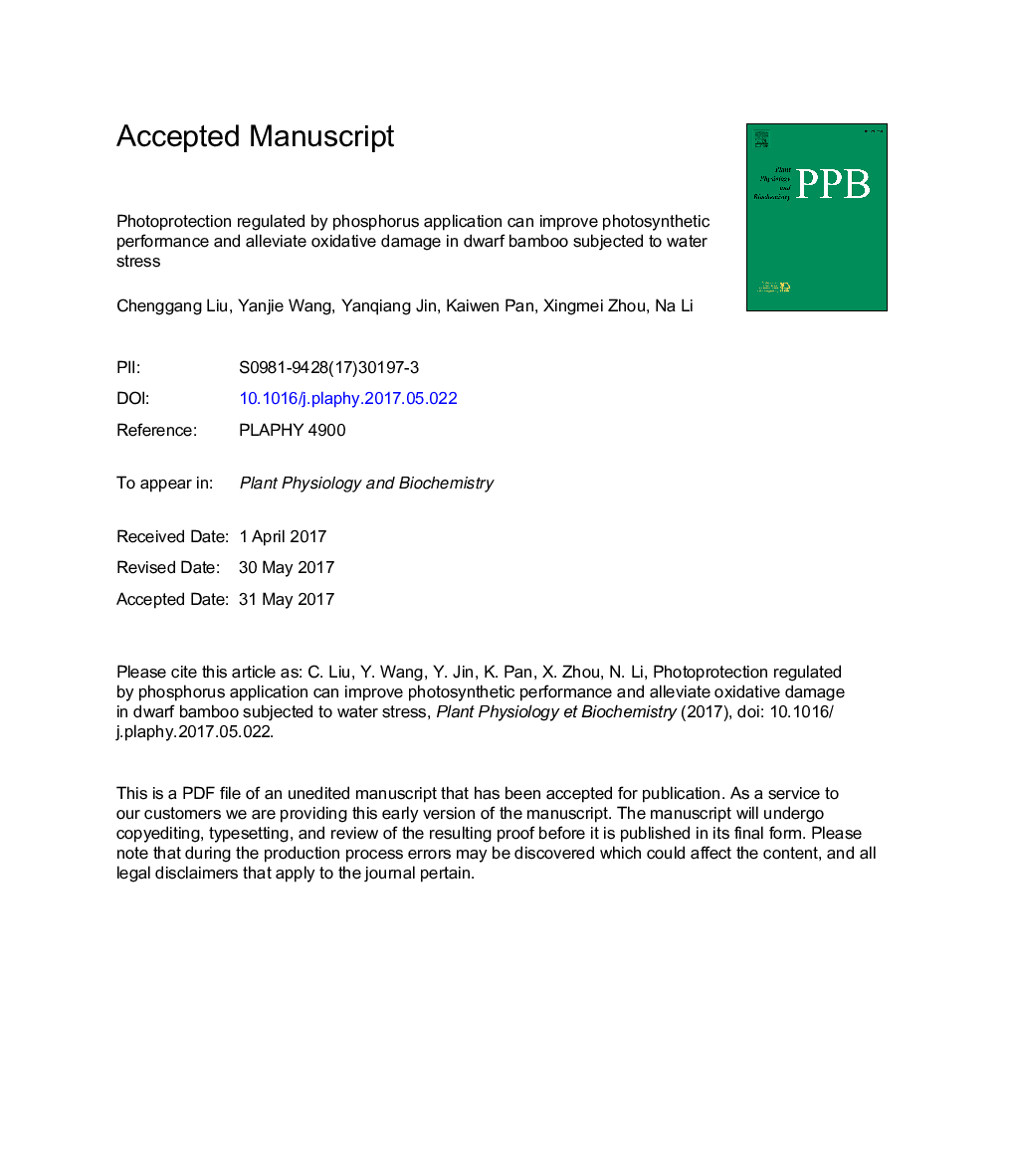| کد مقاله | کد نشریه | سال انتشار | مقاله انگلیسی | نسخه تمام متن |
|---|---|---|---|---|
| 5515425 | 1541903 | 2017 | 34 صفحه PDF | دانلود رایگان |
عنوان انگلیسی مقاله ISI
Photoprotection regulated by phosphorus application can improve photosynthetic performance and alleviate oxidative damage in dwarf bamboo subjected to water stress
ترجمه فارسی عنوان
حفاظت از عکس که با استفاده از فسفر تنظیم می شود می تواند عملکرد فتوسنتزی را بهبود بخشد و باعث کاهش آسیب اکسیداتیو در بامبو کوتوله تحت فشار آب
دانلود مقاله + سفارش ترجمه
دانلود مقاله ISI انگلیسی
رایگان برای ایرانیان
کلمات کلیدی
NPQdehydroascorbate reductaseMDHARoxidized ascorbateΦPSIIDEPsmonodehydroascorbate reductaseLRWCtAsAGSSGCO2 assimilation ratetGSHMDAtotal ascorbatemaximum quantum efficiency of PSIIO2•–quantum yield of PSII electron transportDHARGSHAPXASAFv/Fm - Fv / FmROS - ROSHydrogen peroxide - آب اکسیژنهreduced ascorbate - آسکوربات کاهش یافته استAscorbate - آسکوربات یا ویتامین ثsuperoxide anion - آنیون سوپر اکسیدPhosphorus addition - افزودن فسفرThermal dissipation - تسریع حرارتیOxidative stress - تنش اکسیداتیوDHA - دوکوساهگزائنوئیک اسیدSOD - سدSuperoxide dismutase - سوکسوکس دیسموتازintercellular CO2 concentration - غلظت CO2 بین سلولیmalondialdehyde - مالون دی آلدهیدLeaf relative water content - محتوای نسبی آب برگStomatal conductance - هدایت گرمایشیH2O2 - هیدروژن پراکسیدVAZ - وازascorbate peroxidase - پراکسیداز آسکورباتیXanthophyll cycle - چرخه Xanthophyllreduced glutathione - کاهش گلوتاتیونoxidized glutathione - گلوتاتیون اکسید شدهglutathione reductase - گلوتاتیون ردوکتازtotal glutathione - گلوتاتیون کلReactive oxygen species - گونههای فعال اکسیژن
موضوعات مرتبط
علوم زیستی و بیوفناوری
علوم کشاورزی و بیولوژیک
دانش گیاه شناسی
چکیده انگلیسی
Water and nutrients, particularly phosphorus (P), are the two most limiting factors for dwarf bamboo growth in tropical and subtropical areas. Dwarf bamboo is highly sensitive to water stress and often causes severe P deficiency in its growing soils due to the characteristics of shallower roots and expeditious growth. However, little is known about its photoprotective response to soil water deficit and the underlying mechanisms regulated by P application. In this study, a completely randomized design with two factors of two water regimes (well-watered and water-stressed) and two P levels (with and without P application) was arranged to investigate this issue in dwarf bamboo (Fargesia rufa) plants. Water stress not only decreased water status and photochemical activity but also increased lipid peroxidation due to reactive oxygen species (ROS) accumulation irrespective of P application. In this case, thermal dissipation and antioxidative defense were promoted. Moreover, the role of the waterâwater cycle under this stress still could not be ignored because it accounted for a large proportion of total energy (JPSII). P application significantly enhanced photochemical activity accompanied by increased chlorophyll content in water-stressed plants. Meanwhile, P application remarkably reduced thermal dissipation and hardly affected photorespiration and the waterâwater cycle under water stress. Although P application only enhanced ascorbate (AsA) level, ROS, particularly hydrogen peroxide (H2O2), and lipid peroxidation were significantly reduced in water-stressed plants. Therefore, P application can improve the photosynthetic capacity by regulating the redistribution of energy absorbed by PSII antennae and independently activating of the H2O2-scavenging function of AsA to alleviate oxidative damage in F. rufa plants, thereby improving their survival under water stress conditions.
ناشر
Database: Elsevier - ScienceDirect (ساینس دایرکت)
Journal: Plant Physiology and Biochemistry - Volume 118, September 2017, Pages 88-97
Journal: Plant Physiology and Biochemistry - Volume 118, September 2017, Pages 88-97
نویسندگان
Chenggang Liu, Yanjie Wang, Yanqiang Jin, Kaiwen Pan, Xingmei Zhou, Na Li,
